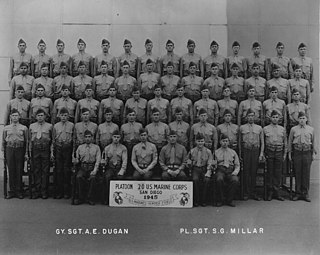
A platoon is a military unit typically composed of two to four squads, sections, or patrols. Platoon organization varies depending on the country and the branch, but a platoon can be composed of 20–50 troops, although specific platoons may range from 10 to 100 people. A platoon is typically the smallest military unit led by a commissioned officer. The platoon leader is usually a junior officer—a second or first lieutenant or an equivalent rank. The officer is usually assisted by a platoon sergeant.
Infantry support guns or battalion guns are artillery weapons designed and used to increase the firepower of the infantry units they are intrinsic to, offering immediate tactical response to the needs of the unit's commanding officer. They typically have short, low-velocity barrels, and light construction carriages, allowing them to be more easily manoeuvered on the battlefield. They are generally used for direct fire, rather than the indirect fire of other types of artillery. Their role has generally been replaced by tanks using tank guns, infantry fighting vehicles using autocannons, other combat vehicles, mortars, recoilless rifles, rocket-propelled grenades, and shoulder-launched missiles.
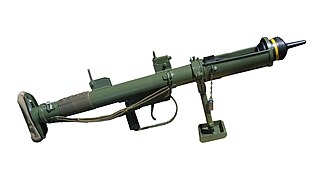
The Projector, Infantry, Anti Tank (PIAT) Mk I was a British man-portable anti-tank weapon developed during the Second World War. The PIAT was designed in 1942 in response to the British Army's need for a more effective infantry anti-tank weapon and entered service in 1943.
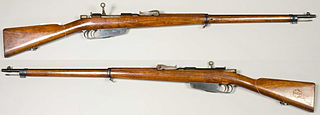
Carcano is the frequently used name for a series of Italian bolt-action, internal box magazine fed, repeating military rifles and carbines. Introduced in 1891, the rifle was chambered for the rimless 6.5×52mm Carcano round. It was developed by the chief technician Salvatore Carcano at the Turin Army Arsenal in 1890, and was originally called the Modello (model) 91 or simply M91. Successively replacing the previous Vetterli-Vitali rifles and carbines in 10.35×47mmR, it was produced from 1891 to 1945. The M91 was used in both rifle (fucile) and shorter-barreled carbine (moschetto) form by most Italian troops during World War I and by Italian and some German forces during World War II. The rifle was also used during the Winter War by Finland, and again by regular and irregular forces in Syria, Libya, Tunisia, and Algeria during various postwar conflicts in those countries.

A section is a military sub-subunit. It usually consists of between 6 and 20 personnel. NATO and U.S. doctrine define a section as an organization "larger than a squad, but smaller than a platoon." As such, two or more sections usually make up an army platoon or an air force flight.

The Fucile Mitragliatore Breda modello 30 also known as Breda 30 or the Alpine scythe (la falce degli Alpini) or Finita Burrasca (The storm is over) was the standard light machine gun of the Royal Italian Army during World War II. The Breda Modello 30 was issued at platoon level and gave Italian rifle squads extra firepower. As a light machine gun it had many problems including jamming and overheating. It was fed by a 20 round stripper clips which had to be oiled by a lubrication device. Despite all its faults it formed the main base of fire for infantry units during the war.

The cannone da 65/17 modello 13 was an artillery piece developed by Italy for use with its mountain and infantry units. The designation means 65 mm calibre gun, barrel length 17 calibres, which entered service in 1913. The designation is often shortened to cannone da 65/17.

The Universal Carrier, also known as the Bren Gun Carrier and sometimes simply the Bren Carrier from the light machine gun armament, is a common name describing a family of light armoured tracked vehicles built by Vickers-Armstrongs and other companies.

The Type 89 grenade discharger, inaccurately and colloquially known as a knee mortar by Allied forces, is a Japanese grenade launcher or light mortar that was widely used in the Pacific Theater of World War II. It got the nickname the "knee mortar" because of an erroneous Allied belief that these launchers could be fired by propping its plate against the leg. However, anyone trying to fire it this way would receive a severe bruise from its hefty recoil.

The Ordnance SBML two-inch mortar, or more commonly, just "two-inch mortar", was a British mortar issued to the British Army and the Commonwealth armies, that saw use during the Second World War and later.
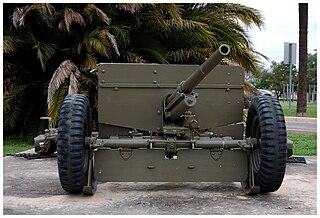
The 37 mm gun M3 is the first dedicated anti-tank gun fielded by United States forces in numbers. Introduced in 1940, it became the standard anti-tank gun of the U.S. infantry with its size enabling it to be pulled by a jeep. However, the continuing improvement of German tanks quickly rendered the 37 mm ineffective and, by 1943, it was being gradually replaced in the European and Mediterranean theaters by the more powerful British-developed 57 mm gun M1. In the Pacific, where the Japanese tank threat was less significant, the M3 remained in service until the end of the war, but some 57mm guns were issued.
A Marine expeditionary brigade (MEB) is a formation of the United States Marine Corps, a Marine air-ground task force of approximately 14,500 Marines and sailors constructed around a reinforced infantry regiment, a composite Marine aircraft group, a combat logistics regiment and a MEB command group. The MEB, commanded by a general officer (usually a brigadier general), is task-organized to meet the requirements of a specific situation. It can function as part of a joint task force, as the lead echelon of the Marine expeditionary force (MEF), or alone. It varies in size and composition, and is larger than a Marine expeditionary unit (MEU) but smaller than a MEF. The MEB is capable of conducting missions across the full range of military operations.

The Royal Italian Army, participated in World War II on the side of the Axis Powers on 1940. The Royal Italian Army notably fought at the Balkans, Western Alps, North and East Africa and Russia until its defeat on 1943 by the Allies. The Royal Italian Army was then turned into the Italian Co-Belligerent Army fighting alongside the Allies while some Italian forces joined the Germans as the National Republican Army on the Italian Social Republic in Northern Italy.
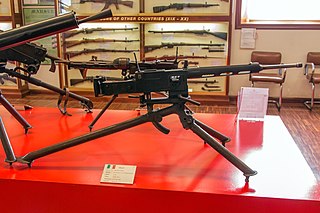
The Fiat–Revelli 35 was an Italian machine gun, a modified version of the Fiat–Revelli Modello 1914, which had equipped the Italian Army of World War I. It was a vast improvement on the early model, offering superior penetration power due to the adoption of belt fed 8mm (8x59) rounds. The Modello 35 also omitted the oil reservoir found on the earlier Modello 14. Later it was found that the new chamber still jammed and rounds had to be lubricated before use. Despite its faults the Modello 35 saw extensive action during World War II.
The Polish Infantry Regiment; during World War 2 comprised on average some 2,900 men and 60 officers organised around 3 rifle battalions armed with either the Karabinek wz.29 or the Wz. 98, 7.92mm bolt-action rifles. Each 19-man squad was also issued the RKM wz.28 light machine gun. Other regimental weapons included the Polish version of the French Model 1897 75-mm field gun, the Wz. 35 anti-tank rifle, the Ckm wz.30 heavy machine gun, the wz.31 81 mm mortar, and the wz.36 46mm light mortar/grenade launcher.

The 11th Parachute Battalion was an airborne infantry battalion of the Parachute Regiment, raised by the British Army in World War II.

The 81/14 Model 35 Mortar was an Italian World War II infantry mortar. It was the standard weapon of the Italian Army during the war, of typical Brandt-system construction, but relatively lightweight, with good range and considered very successful.

The Garland trench mortar was an improvised mortar used by Australian and British forces at Gallipoli during the Dardanelles Campaign of 1915–16. Developed early in the war by Herbert Garland, a pre-war metallurgist and superintendent of laboratories at the Cairo Citadel, it was the most numerous mortar of the Gallipoli Campaign. A simple, improvised design, the Garland mortar consisted of a smoothbore steel barrel fixed at 45 degrees to a solid wooden base. By means of a powder charge it propelled a variant of the jam tin grenade. Its design meant that the whole weapon had to be turned to change its traverse and raised on a box to increase its range but despite these limitations it was reported to have done "good work" in the front line.
The Tromboncino M28 was an interwar period infantry weapon developed by the Italians. It combined a grenade launcher with a carbine.
















